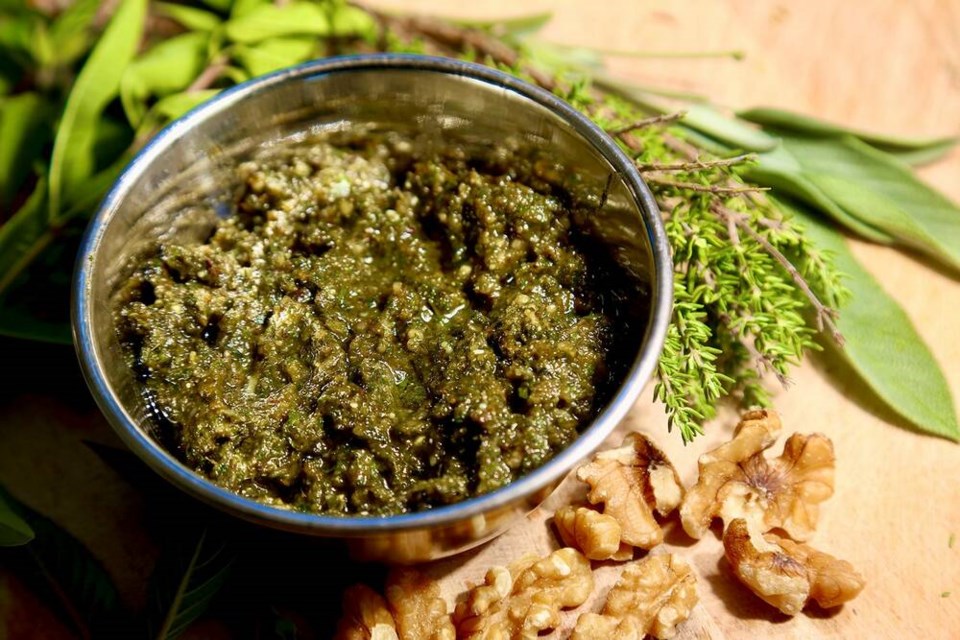The change of weather got ahead of me a bit this year and I wasn’t able to late-summer cut the last wave of herbs in our herb spiral, or the fourth flush of holy basil growing under the faded tomato vines. With any luck I will get to them this sunny weekend, and hang them to dry for gifting, and for use throughout the winter.
“Make hay” though, they say, so I improvised and made Thanksgiving Pesto. Such a blessing, in hindsight, to have a variety of fresh herbs at-hand in October, with which to make a small-batch of gorgeous and incredibly nutrient-dense mixed herb, walnut and pecorino pesto to flavour and enrich our Thanksgiving meal.
I will likely make a jumbo patch in my large food processor, and freeze it in 250-millilitre deli cups. Making pesto for freezing is easy, just remember to omit any acid components like lemon or vinegar, until after it has thawed, otherwise the greens could oxidize and turn your lovely greens to brown before their time.
My mixed herb pesto was dark green to begin with, because I used traditional so-called poultry herbs like sage and thyme, in addition to basil. The traditional pesto basil is the Genovese or sweet variety, but I prefer and used holy basil (Ocimum tenuiflorum), which tastes similar to popular basil, but is actually a mint-family plant that contains diverse and numerous beneficial phytochemicals, coveted by Ayurvedic practitioners.
To spice things up further, I added pineapple sage leaves and blossoms, lemon verbena leaves, and creeping winter savoury leaves and blossoms. The herb mixture was random, though the mixed herb to holy (or regular) basil ratio works best at two-thirds mixed herbs to one-third basil.
My goal was to produce a 250 ml pesto, so I worked backwards from my tried and true pesto recipe of two cups by volume of herbs, 60 ml of olive oil (or as needed), one-half cup by volume of walnuts – substantial health benefits and far less expensive than equally “oily” pine nuts (off-shore sources known to contain heavy metals), one-quarter cup of grated pecorino cheese – made from pasture-raised sheep milk (very low lactose), and a large pinch of sea salt (or to taste).
Anyone with a small food processor or a mortar and pestle can make pesto. Start by stripping the herb leaves and flowers from the stalks, and process or crush until reduced to small pieces, add the olive oil in a stream until the herbs move freely but are not soupy. Add the walnuts and process or crush until incorporated, then add the grated pecorino and salt. Process or crush just until combined as the small bits are lovely and provide colour and texture. If using right away, you might add the juice of half a lemon just before incorporating into your recipe, though I often use the pesto as-is without adding lemon at all.
I have not yet decided if I will place the pesto between the skin and flesh of a whole bird to be roasted, use as a stuffing layer in a turkey breast roulade (roll), incorporate into a light olive oil dressing for a pappardelle side dish, or drizzle over oven-roasted spaghetti squash. A little goes a very long way, so use a slight hand and quality olive oil to thin before using as a sauce or drizzle.
What I know for certain is that my mixed herb, walnut and pecorino pesto is a gorgeous good-for-you food that came from living soil in our home garden. For that, and for so many, many things, I am truly grateful.
Happy Thanksgiving everyone!
Laura Marie Neubert is a West Vancouver-based urban permaculture designer. Follow her on Instagram , learn more about permaculture by visiting her website or email your questions to her here.
For a taste of permaculture, watch the video below:




